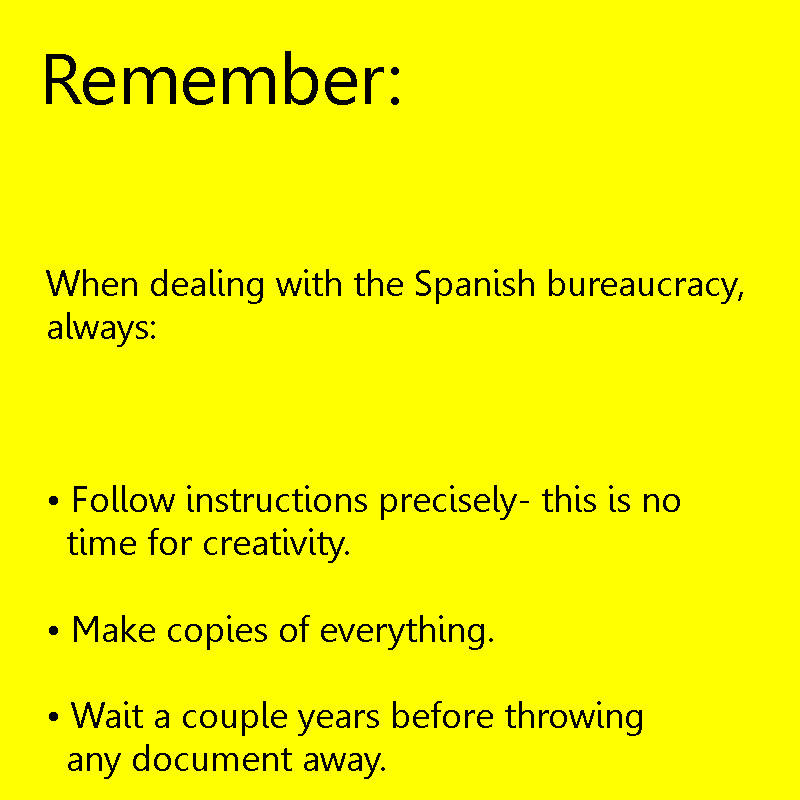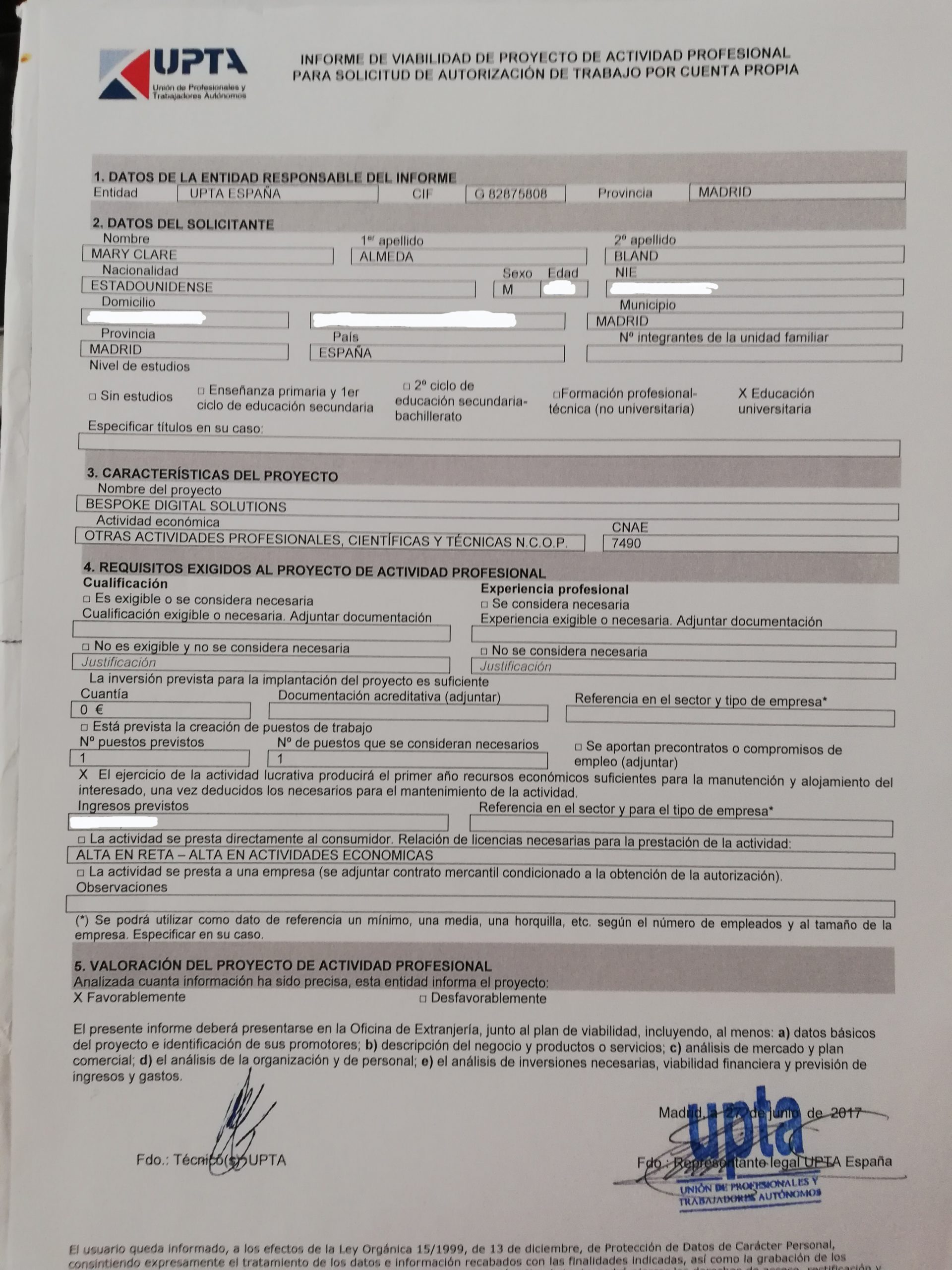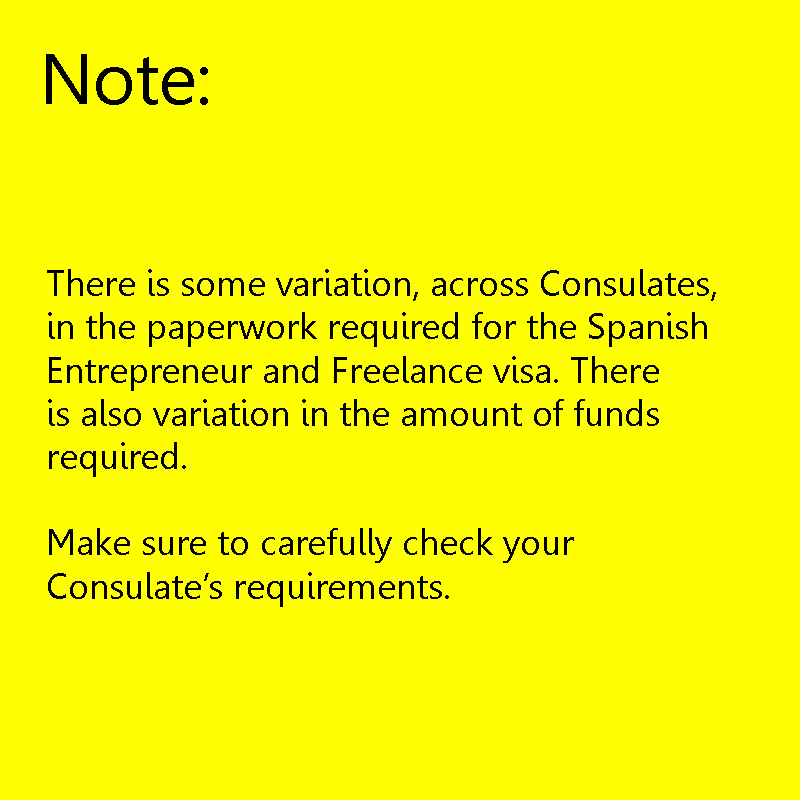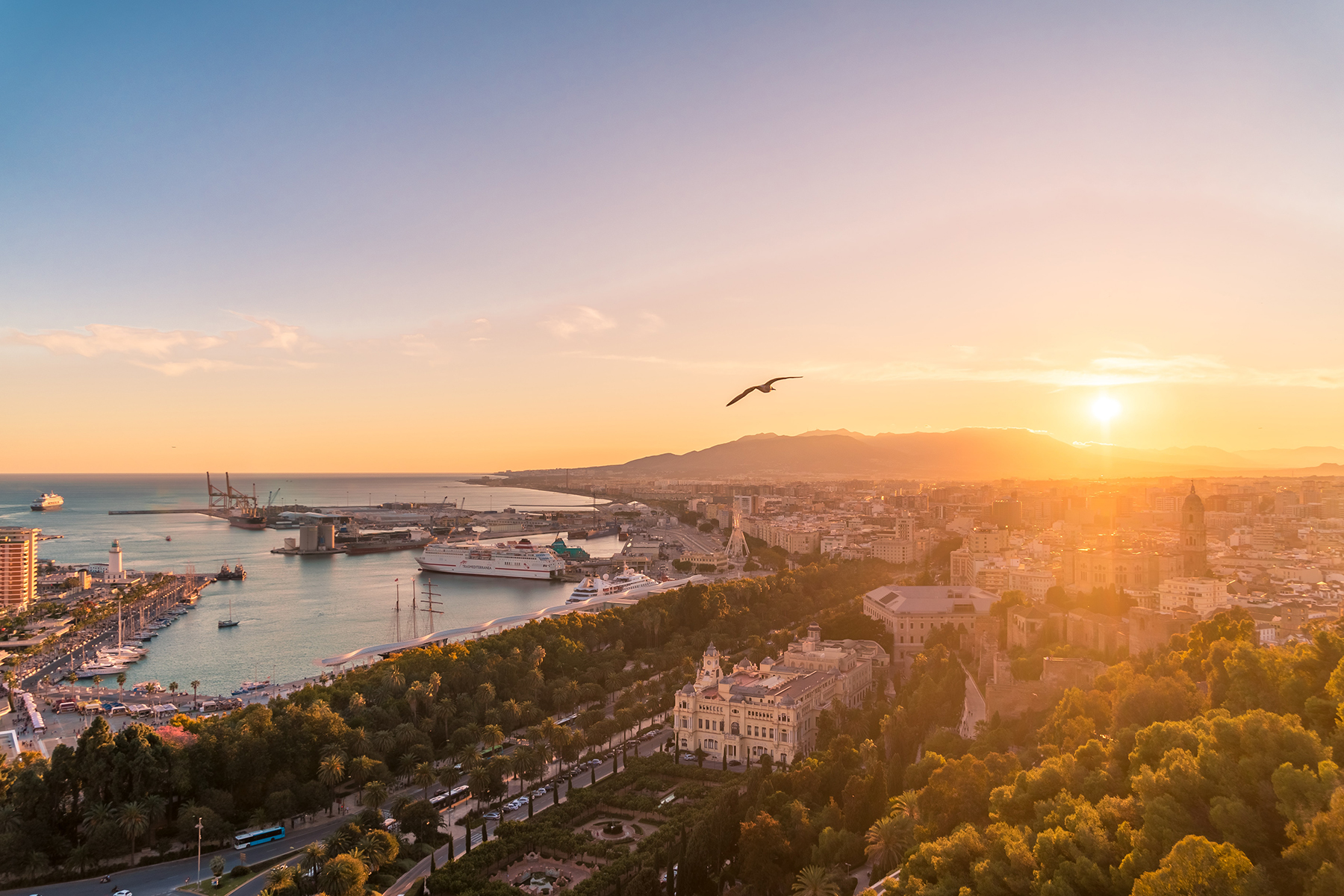M3- Additional paperwork required for the Spanish Freelance Visa
This module provides the following information:
- Paperwork you need to submit that is specific to the Spanish Freelance Visa, whether you apply in Spain or abroad. This includes a copy of the business plan I used to successfully apply for a Spanish Freelance Visa.
- The process for applying for a Spanish Freelance Visa, both in Spain and from abroad.

Paperwork required regardless of where you apply
As mentioned in the previous module, you need the following paperwork to apply for a freelance visa in Spain:
- A copy of your police record, Apostilled and translated into Castillan by an official translator. If you have lived in any other country for the past five years, you must provide a police report from there as well.
- Police records for family members applying with you that are 18 years or older. They must be Apostilled and translated into Castillan by an official translator.
- Proof of health insurance that is valid in Spain, for you and your family members.
- A copy of every page of your passport and every family member that is applying with you.
- A business plan. If you apply for a freelance visa, I highly recommend you ask an independent agency to pre-approve your plan. There are a handful that provide the service. I used one called UPTA. I worked with a couple of other agencies helping other people, but I think UPTA is the best.
- If your business plan has been approved by UPTA (or other accepted agency), a copy of your favorable report.
Here is a copy of the business plan, and accompanying financial statements, I submitted to get my Spanish Freelance Visa. The business was considered to be in the technology field, and strategic to the Spanish government.
Note: To see the full plan and financial statements, you have to go to the bottom of the first page and hover your mouse over the bottom of the page. On the left-hand side is a little arrow. Click on that to see the pages. Please remember that these business plans and financials are my property that I am sharing with course members. Please do not share with others that did not pay to take this course.
Bespoke Digital Solutions Business plan redacted
Apologies, but I couldn’t find the English versions of the financial statements. Here are the Spanish ones:
CASH FLOW STATEMENT REDACTED
P&L REDACTED
REVENUE FORECAST REDACTED
Working with UPTA
I was very impressed with UPTA. I walked in (without an appointment) and someone saw me almost immediately. I explained that I needed my business plan reviewed to apply for a Spanish Freelance Visa. I left the plan with them and gave them my email address. They didn’t charge me for the service as I was in the country legally, regularly paid my social security contributions and had a NIE. I think they charge around 50€ for the service is you aren’t in the system, but can’t confirm that. It might be less.
After about a week they emailed me some small changes they recommended I make. It wasn’t anything major. The main issue is I had numbers in the business plan in different currencies and they all had to be changed to euros.
I made the requested changes. A couple of days later they said their report was ready. I went down and picked it up- I was awarded a favorable report. I made a copy of this report and submitted it with the rest of my documents. Here is what it looks like:

Additional required documentation for the Spanish Freelance Visa
1– Proof that you have funds sufficient to sustain yourself
Submitting in Spain
If you apply for an entrepreneur visa in Spain, you have to show you have funds sufficient to sustain yourself for two years. This has to be at least 24 times (to cover two years of living expenses) what the Spanish government considers sufficient monthly income to survive. This monthly income number is called the Indicador Público de Renta de Efectos Múltiples (IPRM). In 2020, this number is 537.84€.
You must demonstrate additional funds for each family member you bring with you. You have to demonstrate 537.84€ per month for yourself plus 268.92€ for each additional family member.
If your bank statements are in English, you will need to have them translated into Spanish before you submit them. Again, they need to be sworn translations.
Submitting abroad
The Consulates do not publish very clear guidance on this. Some, like the New Delhi Embassy, state you need to provide, “Proof of availability of the funding required for the projected activity.” The Mexico City Consulate says something similar.
The New York Consulate says you must provide, “Documentation that shows that you are financially sound or letter/s from the bank/s regarding that matter and translated into Spanish.”
The Los Angeles Consulate provides a link to the financial means you must prove you have to be approved for different visa types, but the freelance visa is not listed in the table.
If you want to be safe, I recommend showing you have 1,075.68€ per month to sustain yourself for the first year.
Again, be sure to check your Consulate’s website for further guidance.
If you apply with family members, you have to prove you have the funds to sustain them as well. If you want to be safe, I recommend you demonstrate an additional 537.84€ for each family member that you bring with you.

Again, all bank statements must be translated into Spanish by a licensed translator.
2– Medical certificate
Submitting in Spain
You do not need to submit this if you apply in Spain
Submitting abroad
You must submit a doctor’s statement, on their official letterhead, indicating that you have been examined and found in good physical and mental health to travel and live abroad. It must certify you are free of contagious diseases or any other illnesses which could lead to public health repercussions according to the 2005 International Sanitary Regulations of the World Health Organization.
3– Proof of academic title or degree (if required for your line of work)
Submitting in Spain or abroad
If a degree is required in your line of work, you must submit a copy of it, translated into Spanish by a sworn translator and Apostilled.
If you have a higher degree, I recommend submitting a copy of it, even if not required for you to do business. The bureaucracy loves advanced degrees and it can only help your case.
4– List of authorizations and permits you need to open or conduct your future business
Submitting in Spain or abroad
If permit(s) are required for you to open your business, you must submit a copy of each, translated into Spanish by a sworn translator and Apostilled.
I did not submit any permits when I initially applied for my Freelance Visa.
5– List of current clients
Submitting in Spain or abroad
You technically don’t have to submit a client list, but if you have them I highly recommend doing so. Alternatively, you can include them in your business plan, which is what I did. As always, make sure everything is translated into Spanish by a sworn translator and Apostilled.
6– Application forms
You must submit application forms when you apply for a Freelance Visa.
Submitting in Spain or abroad
Here is the application form you need to complete if you submit your application in Spain or abroad: EX-07: Solicitud de autorización de residencia temporal y trabajo por cuenta propia
If you submit abroad, many Consulates ask you to submit two copies of the form.
Video: How to fill out form EX-07
Forms for family members
Submitting in Spain
If you submit in Spain, you must fill out and submit a copy of this form for each family member applying with you: EX-01: Solicitud de Autorización de Residencia Temporal y No Lucrativa
Video: How to fill out form EX-01
Submitting abroad
Most Consulates ask you to submit the same form for family members that are used in Spain: the EX-01 listed above. However, make sure to verify with your local Consulate as I noticed a couple of them using this form: Application for a National Visa. This form is in English and relatively straightforward, so I am only including a video for the form in Spanish.
NOTE: If you are submitting an application for a family member, you must also submit documents proving your family ties. For a spouse, this is a marriage certificate. For children, this is their birth certificate(s). For dependent parents, this is their birth certificate and that of you or your spouse. All must be translated into Spanish and carry an Apostille. For a significant other, you have to register your union with the authorities. Here is how you do it in Madrid: Registro de Uniones de Hecho
7– Proof you have paid the taxes
Submitting in Spain and abroad
The forms are the same whether you submit in Spain or abroad. There are two. Form 790 Code 52 is for a general residence permit, Form 790 Code 62 is specific to applying for a freelance visa.
Here are videos that show you how to complete both forms:
Video: How to download the form and pay tax for Form 790, code 52
Video: How to download the form and pay tax for Form 790, code 62
Once you complete the forms, take them to the counter of a bank and pay the tax (bring cash with you). Many banks no longer accept counter transactions from people that are not their customers. However, if this is the case you can pay it at the ATM/Cashpoint/cajero of major banks such as: Santander, Bankia and BBVA. If you need help, go inside and someone will always come out and help you. Regardless, make sure you keep the receipts! These are what you submit with your visa application.
If you are applying abroad, bring it to your appointment at the Consulate and ask them how they want you to pay it.
Tax forms for family members
For each family member applying with you, you must pay the tax and submit the above form: Modelo 790 Código 52
8– Passport photos
Submitting in Spain
If you submit it in Spain, you don’t need to submit passport photos. You do this later, when you go to get your residency card made.
Submitting abroad
If you submit abroad, you must supply two passport photos of yourself, and two for everyone else applying with you. They must be color photos, 2 x 2 inches (51 x 51 mm) in size, printed on matte or glossy photo quality paper, taken within the last six months. They must reflect your current appearance and you must stand in front of a plain white or off-white background.
9– Consular fees
Submitting in Spain
If you submit in Spain, you do not have to pay Consular fees.
Submitting abroad
If you submit abroad, you will likely have to pay additional Consular fees to process your application. Make sure to check with your Consulate for the amount and how to pay them, as it differs across Consulates.
10– Additional documentation provided by Consulate
Submitting in Spain
If you submit in Spain, this does not apply.
Submitting abroad
Make sure to read the Consulate’s website very carefully. Make sure to enquire, when you go to your appointment, that you have all the correct documentation they require.
How to apply for the Spanish Freelance Visa
Applying in Spain
If you apply in Spain, you are actually applying for a temporary (two years) residence permit. Unlike with the Entrepreneur Visa, you still have to apply in person.
NOTE: If you look at the individual Consulate websites, they all say you have to apply for a Spanish Freelance Visa in your home country. I have even read blog posts by people that were living in Spain but went back to their home countries to apply for the visa. However, I successfully applied in-country and I know another person that applied here (although she has yet to receive her results). The portal to book appointments to apply for the Spanish Freelance Visa clearly allows you to apply in-country. Based upon this, and my successful application, I think this is just a case of one part of the Spanish bureaucracy not communicating with others. However, if you come to Spain and for some reason they don’t accept your application, I am not liable. This course offers information and advice, not a promise that you will successfully obtain your residence permit/visa.
First, you need to assemble all of your documentation and convert to PDFs.
Once you do that, you go here to make an appointment: Cita Previa de Extranjería
You will actually not be making an appointment (see video below). Rather, you will be downloading a PDF that you can fill out. Once you complete it, sign, date and put in PDF form, you email that along with:
- All your PDFs with your paperwork
- A request for an appointment (cita previa)
to the following address: citaprevia_extranjeria.madrid@correo.gob.es
They will email and send you a text message with further instructions.
Video: How to apply for a Freelance Visa in Spain
On the date of your appointment, I recommend going to the office indicated and bring all of your documentation. Make photocopies of everything before you go. As I mention in the video, this is a very new process and I don’t know anyone that has gone to an appointment. If you go, please email me and tell me what happens so I can update this and tell everyone else.
If you don’t hear anything in three months, your application is approved due to administrative silence. I didn’t actually believe this happened, but when I renewed my freelance visa, I was approved for exactly that reason.
Your approval letter will tell you where to make an appointment to get your identity card made and what you need to bring with you (a completed form, a passport photo and, as usual, a form that says you paid the tax).
Applying from abroad
If you are applying from abroad, you:
- Make an appointment at your Consulate.
- Bring all your documents for you and your family to your appointment.
- Once your visa is approved, you go back to the Consulate and collect it.
- Travel to Spain within the period the visa is valid for. Once in Spain, you have one month to go to the police station and request your residence card (TIE).
Again, please make sure to verify the process by checking your local Consulate’s website.
